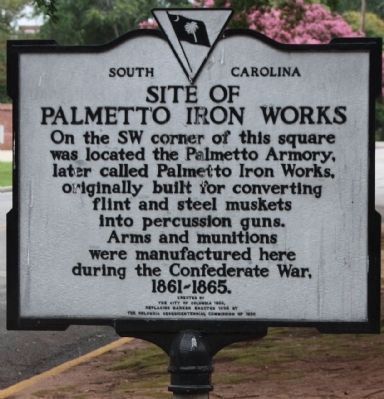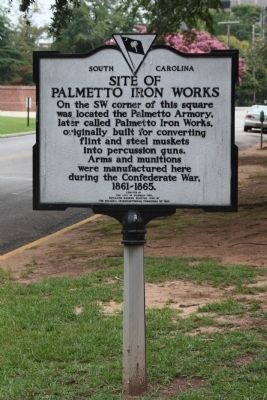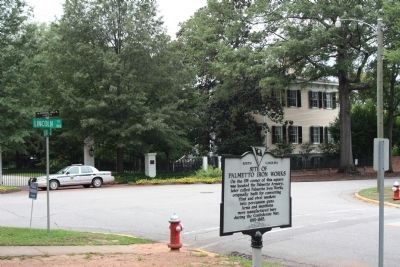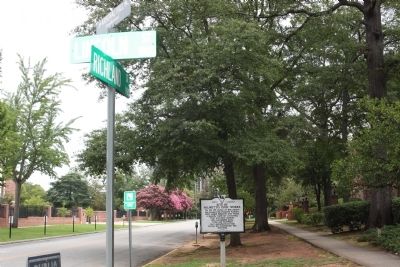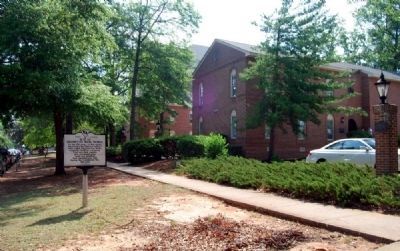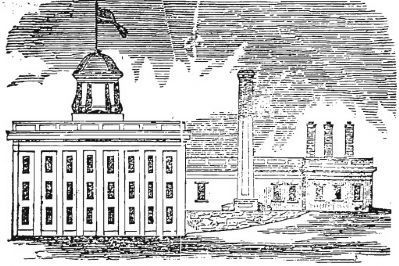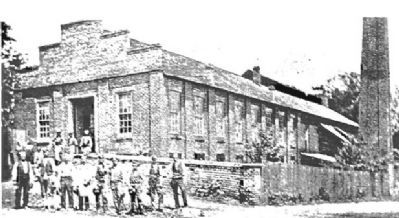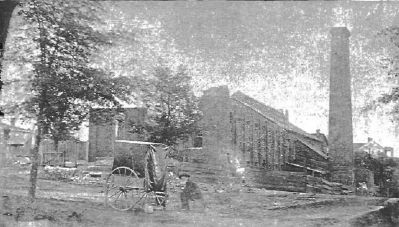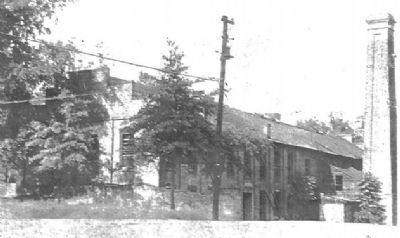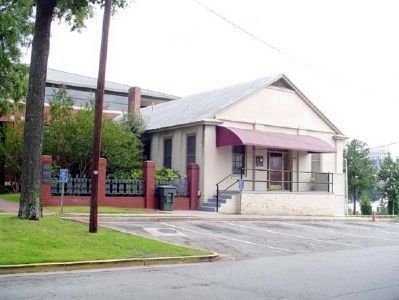Arsenal Hill in Columbia in Richland County, South Carolina — The American South (South Atlantic)
Site of Palmetto Iron Works
On the SW corner of this square was located the Palmetto Armory, later called Palmetto Iron Works, originally built for converting flint and steel muskets into percussion guns. Arms and munitions were manufactured here during the Confederate War, 1861-1865.
Erected 1966 by City of Columbia, replacing marker erected 1938 by the Columbia Sesquicentennial Commission of 1936. (Marker Number 40-13.)
Topics. This historical marker is listed in these topic lists: Industry & Commerce • War, US Civil.
Location. 34° 0.541′ N, 81° 2.534′ W. Marker is in Columbia, South Carolina, in Richland County. It is in Arsenal Hill. Marker is at the intersection of Richland Street and Lincoln Street, on the left when traveling west on Richland Street. Located near Lincoln St. Gate to Governors Mansion. Touch for map. Marker is in this post office area: Columbia SC 29201, United States of America. Touch for directions.
Other nearby markers. At least 10 other markers are within walking distance of this marker. Philip Simmons (within shouting distance of this marker); Palmetto Arsenal / Iron Works (within shouting distance of this marker); Governor's Mansion (within shouting distance of this marker); Boylston House & Boxwood Gardens (about 300 feet away, measured in a direct line); The Gonzales Fountain (about 300 feet away); Lord John Berkeley (about 300 feet away); Lord Ashley (about 400 feet away); Earl of Clarendon (about 400 feet away); Sir John Colleton (about 400 feet away); Sir George Carteret (about 400 feet away). Touch for a list and map of all markers in Columbia.
Regarding Site of Palmetto Iron Works. Palmetto Iron Works and Armory Significant as one of Columbia’s early manufacturing concerns, the Palmetto Iron Works was built in 1850 by William Glaze and a Mr. Boatwright for making ornamental iron works. It became known as the Palmetto Armory in 1851 when the State of South Carolina contracted with William Glaze and Company to manufacture specific numbers of muskets, rifles, pistols, cavalry sabers and artillery swords. This manufacture of military weapons from 1851-1853 helped to supply the South Carolina Militia for the Civil War. By Gen. Sherman’s February 16, 1865 Field Order No. 26 the Armory smokestacks were damaged beyond repair and all machinery destroyed. After the Civil War, George A. Shields rebuilt the foundry and by 1888 directed a thriving business that continued into the twentieth century. The remaining walls of the original main three-story building were used in the rebuilding. The third story, cornice, parapet, and dome of the original building were replaced by a gabled tin roof. Bought by the City of Columbia in 1942, it has been adaptively reused as a community center. The Palmetto Iron Works and Armory are also called “Arsenal Hill,” a name associated with this section since the days when the old arsenal stood nearby. ( South Carolina Department of Archives and History.)
Also see . . .
1. Arsenal Hill (Palmetto Iron Works and Armory). Significant as one of Columbia’s early manufacturing concerns, the Palmetto Iron Works was built in 1850 by William Glaze and a Mr. Boatwright for making ornamental iron works. (Submitted on July 30, 2011, by Brian Scott of Anderson, South Carolina.)
2. Historical, Architectural, and Archaeological Survey of the Palmetto Iron Works. 1993 report detailing a survey of the Palmetto Iron Works. (Submitted on July 31, 2011, by Brian Scott of Anderson, South Carolina.)
Additional commentary.
1. Arsenal Hill (Palmetto Iron Works and Armory) - National Register Nomination (1971)
Description
An 1855 sketch of the Palmetto Iron Works and Armory with a view to the north shows a three story main building three bays
wide and eight bays in length, topped by a large cornice, paneled parapet, and dome supported by columns which is surmounted by a flag pole. To the east, at the northern side of the building is a one story building with identical cornice and parapet. The small building also has three two-story chimneys. An exterior chimney midway between the east end of the main building and east end of the factory complex is also visible.
Today the outlaying building and exterior chimney no longer remain. When the Iron Works was rebuilt after the Civil War, the remaining walls of the main building were used. Third story, cornice, parapet and dome were replaced by a gable tin roof. Modern extensions of second story provides facilities. Evidence of original brick may still be seen on exterior and interior.
Significance
Significant as one of Columbia's early manufacturing concerns, Palmetto Iron Works was built in 1850 by William Glaze and a Mr. Boatwright for making ornamental iron works.
Significant industrially, it became known as Palmetto Armory in 1851 when the State of South Carolina contracted with William Glaze and Company to manufacture specific numbers of muskets, rifles, pistols, cavalry sabres, and artillery swords. Mat 31st of the same year the firm agrees to convert flint arms of the S.C. Militia to percussion firearms. This manufacturer of military
weapons from 1851-1853 helped to supply S.C. Militia units for the Civil War.
1854-1864 saw a return to production of iron works for commercial use.
Significant military as an important Confederate source for bomb shells, cannon balls, mine balls and rollers for Raleigh and Columbia powder mills. Be Sherman's February 16, 1865 Field Order No. 26 the Armory smokestacks were damaged beyond repair and all machinery destroyed.
After the war, George A. Shields rebuilt the foundry and by 1888 directed a thriving business which continued into the 20th Century.
Bought by the City of Columbia in 1942, it has been adaptively remodeled as a community center and serves as a useful community facility. Called "Arsenal Hill,' a name associated with this section since the days when the old arsenal stood nearby.
The building is a significant landmark of Columbia Historic District #1, now listed on the National Register of Historic Places.
— Submitted July 31, 2011, by Brian Scott of Anderson, South Carolina.
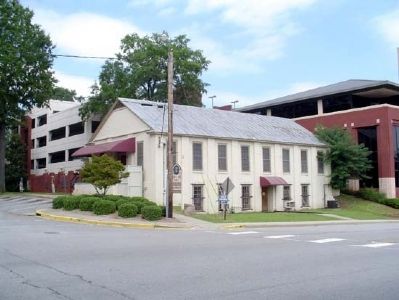
South Carolina Department of Archives and History, September 21, 2006
11. Site of Palmetto Iron Works
Listed in the National Register .
Arsenal Hill ** (added 1971 - Building - #71000795) • Also known as Palmetto Iron Works and Armory; • 1800 Lincoln St., Columbia • Historic Significance: Event • Area of Significance: Industry, Military • Period of Significance: 1850-1874 • Owner: Local Gov't • Historic Function: Industry/Processing/Extraction • Historic Sub-function: Manufacturing Facility • Current Function: Social • Current Sub-function: Civic •
Arsenal Hill ** (added 1971 - Building - #71000795) • Also known as Palmetto Iron Works and Armory; • 1800 Lincoln St., Columbia • Historic Significance: Event • Area of Significance: Industry, Military • Period of Significance: 1850-1874 • Owner: Local Gov't • Historic Function: Industry/Processing/Extraction • Historic Sub-function: Manufacturing Facility • Current Function: Social • Current Sub-function: Civic •
Credits. This page was last revised on February 16, 2023. It was originally submitted on August 20, 2009, by Mike Stroud of Bluffton, South Carolina. This page has been viewed 2,369 times since then and 62 times this year. Photos: 1. submitted on September 30, 2010, by Mike Stroud of Bluffton, South Carolina. 2, 3, 4. submitted on August 20, 2009, by Mike Stroud of Bluffton, South Carolina. 5, 6, 7, 8, 9. submitted on July 31, 2011, by Brian Scott of Anderson, South Carolina. 10, 11. submitted on August 20, 2009, by Mike Stroud of Bluffton, South Carolina. • Craig Swain was the editor who published this page.
